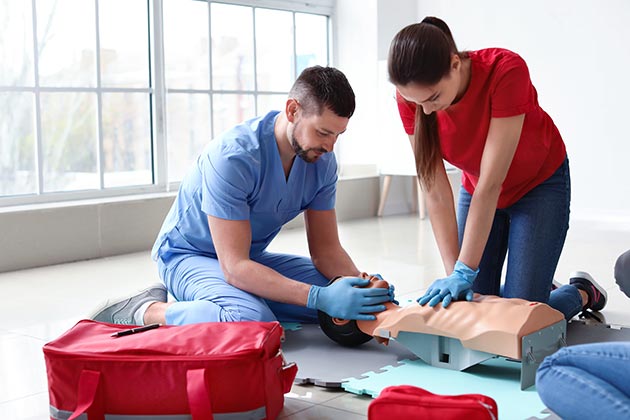Contents
- 1 Understanding the Importance of First Aid and CPR
- 2 The Basics of CPR: What You Need to Know
- 3 Assessing the Situation: When to Perform CPR
- 4 Step-by-Step Guide: Performing CPR on Adults
- 5 Tailoring CPR for Children and Infants
- 6 Common Mistakes to Avoid During CPR
- 7 CPR Training and Certification: Where to Start
- 8 Enhancing Your CPR Skills: Tips and Techniques
- 9 CPR in Special Situations: Choking and Drowning
- 10 The Emotional Impact of Performing CPR
First Aid for CPR – When it comes to emergency situations, being equipped with the knowledge of first aid can make all the difference. One of the most crucial life-saving techniques is Cardiopulmonary Resuscitation, commonly known as CPR. In this comprehensive guide, we will explore the essential steps and techniques for administering CPR effectively. Whether you are a concerned parent, a healthcare professional, or simply someone who wants to be prepared for any unforeseen circumstances, this article will provide you with the necessary information to confidently perform CPR. So, let’s dive in and learn how to potentially save a life!
Understanding the Importance of First Aid and CPR
In emergency situations, having knowledge of first aid and cardiopulmonary resuscitation (CPR) can make a critical difference in saving lives. First aid involves providing immediate care to injured or ill individuals until professional medical help arrives. CPR, on the other hand, is a technique used to manually pump blood and oxygenate the body when a person’s heart has stopped beating or they have stopped breathing.
First aid and CPR skills are essential for everyone to learn, regardless of their profession or background. Whether you’re a concerned parent, a teacher, or an office worker, being equipped with these skills can enable you to respond effectively when emergency situations arise.
Why Learn First Aid and CPR?
Learning first aid and CPR has several important benefits:
- Immediate Assistance: In emergencies, providing immediate care can increase the chances of survival and reduce the severity of injuries.
- Empowerment: Acquiring these skills empowers individuals to take action and make a positive impact in critical situations.
- Preparedness: Knowing first aid and CPR equips you to handle a wide range of emergencies, from minor injuries to life-threatening situations.
- Community Contribution: Being trained in first aid and CPR enables you to assist others in need, both within your immediate circles and in the community at large.
- Bridge to Professional Help: First aid and CPR provide vital support until professional medical assistance can be accessed.
By learning first aid and CPR, you become an invaluable asset in emergencies, potentially saving lives and making a positive impact on those around you.
The Basics of CPR: What You Need to Know
CPR, which stands for Cardiopulmonary Resuscitation, is a life-saving technique used to manually keep blood and oxygen flowing in a person’s body when their heart has stopped beating or they have stopped breathing. It involves a combination of chest compressions and rescue breaths to maintain vital functions.
How CPR Works
During CPR, the main goal is to keep blood circulating throughout the body, supplying oxygen to vital organs and tissues. This is achieved through two primary actions:
- Chest Compressions: By applying firm pressure to the person’s chest, you help manually pump blood from the heart to the rest of the body. This mimics the pumping action of a normally functioning heart.
- Rescue Breaths: In addition to chest compressions, rescue breaths are given to provide oxygen to the person’s lungs. These breaths help oxygenate the blood, which is then circulated by the chest compressions.
When to Perform CPR
CPR should be initiated if an individual:
- Is Unconscious: If a person is unresponsive and not showing any signs of movement or awareness.
- Is Not Breathing: If a person is not breathing or only gasping for breath. This includes situations where they have no pulse.
- Has No Signs of Circulation: If a person shows no signs of blood circulation, such as a lack of pulse or responsiveness.
It’s important to note that CPR is not meant to restart the heart but rather to maintain blood and oxygen flow until professional medical help arrives.
Understanding the basics of CPR is essential for anyone, as it equips them with the knowledge to respond effectively in emergency situations. In the following sections, we will explore the step-by-step process of performing CPR on adults, children, and infants, as well as highlight the necessary modifications for each group.
Assessing the Situation: When to Perform CPR
Knowing when to administer CPR is crucial, as it can significantly impact the chances of a positive outcome. Understanding the signs that indicate the need for CPR enables you to respond promptly and provide timely care. Here are the key indicators to look for:
Unconsciousness
If an individual is unresponsive and does not show any signs of consciousness, it is essential to assess whether they are breathing or have a pulse. Check for responsiveness by gently shaking them and calling their name. If there is no response, proceed to check their breathing and pulse.
Absence of Breathing
If the person is unresponsive and not breathing or only gasping for breath, it is a clear sign that CPR needs to be initiated. Lack of breathing indicates that oxygen is not reaching vital organs, and immediate intervention is required to maintain blood circulation.
No Signs of Circulation
Another crucial indicator for performing CPR is the absence of signs of circulation. Check for a pulse on the person’s neck or wrist. If no pulse is detected and the person remains unresponsive, CPR should be started immediately.
Remember, it is better to err on the side of caution and initiate CPR when in doubt. Starting CPR as soon as possible increases the chances of a successful resuscitation and can potentially save a life.
In the next section, we will provide a detailed guide on performing CPR on adults, outlining the step-by-step process to ensure effective chest compressions and rescue breaths.
Step-by-Step Guide: Performing CPR on Adults
Administering CPR on adults requires a systematic approach to ensure effective chest compressions and rescue breaths. By following these step-by-step instructions, you can confidently provide life-saving care:
Step 1: Assess the Situation
Before initiating CPR, ensure the safety of the environment and assess the person’s responsiveness. If they are unresponsive and not breathing or only gasping, proceed to the next step.
Step 2: Call for Help
Immediately call emergency services or ask someone nearby to do so. Time is of the essence, and professional medical help is crucial for a positive outcome.
Step 3: Position the Person
Lay the person flat on their back on a firm surface. Ensure their head and neck are in a neutral position, with the airway open and unobstructed.
Step 4: Perform Chest Compressions
Place the heel of one hand on the center of the person’s chest, slightly above the lower half of the breastbone. Place the other hand on top, interlacing your fingers. Position yourself directly above the person’s chest, with your shoulders aligned over your hands.
Using your body weight, press downward firmly and smoothly, compressing the chest at least 2 inches. Allow the chest to fully recoil between compressions, but try to maintain a consistent rhythm of approximately 100-120 compressions per minute.
Step 5: Deliver Rescue Breaths
After every 30 chest compressions, provide two rescue breaths. Tilt the person’s head back slightly, pinch their nose shut, and create a seal over their mouth with yours. Deliver a breath that lasts about one second, watching for the chest to rise. Repeat for the second breath.
Step 6: Continue CPR
Alternate between 30 compressions and two rescue breaths, maintaining the same ratio. Continue CPR until professional medical help arrives or the person shows signs of movement or consciousness.
Remember, the quality and consistency of compressions and breaths are crucial for effective CPR. Regularly reassess the person’s condition and adjust your approach as necessary. In the following sections, we will discuss CPR techniques specifically tailored for children and infants.
Tailoring CPR for Children and Infants
While the basic principles of CPR remain the same for adults, performing CPR on children and infants requires certain modifications to ensure their safety and well-being. Here’s what you need to know:
Step 1: Assess the Situation
Just like with adults, assess the child or infant for responsiveness. Tap their shoulder gently and shout, “Are you okay?” If there is no response or movement, proceed to the next steps.
Step 2: Call for Help
Immediately call emergency services or ask someone nearby to do so while you attend to the child or infant. Time is critical, and professional medical assistance is crucial for their well-being.
Step 3: Position the Child or Infant
Place the child or infant on a firm surface, such as the ground or a table. Ensure their head is in a neutral position, and their airway is open and unobstructed. For infants, a slightly tilted head is recommended.
Step 4: Modify Chest Compressions
For children aged 1 to puberty, use the heel of one or both hands, depending on the child’s size, to perform chest compressions. Compress the chest at least one-third the depth of the chest, or about 2 inches. Maintain a steady rhythm of approximately 100-120 compressions per minute.
For infants under the age of 1, use two fingers, either the middle and ring finger or the index and middle finger, to perform chest compressions. Compress the chest about one-third the depth of the chest, or about 1.5 inches. Maintain a steady rhythm of approximately 100-120 compressions per minute.
Step 5: Modify Rescue Breaths
For both children and infants, deliver rescue breaths by covering their mouth and nose with your mouth. For children, provide breaths that last about one second, watching for the chest to rise. For infants, deliver gentle puffs of air, enough to see the chest rise.
Step 6: Continue CPR
Alternate between compressions and rescue breaths, following the appropriate ratios for children and infants. Continue CPR until professional medical help arrives or the child or infant shows signs of movement or consciousness.
Adapting CPR techniques for children and infants is crucial for their safety and optimal care. In the next sections, we will discuss common mistakes to avoid during CPR and the importance of CPR training and certification.
Common Mistakes to Avoid During CPR
While knowing how to perform CPR is essential, it’s equally important to be aware of common mistakes that can hinder its effectiveness. By understanding these errors, you can ensure that your CPR efforts are as impactful as possible:
Mistake 1: Delaying CPR
One common mistake is hesitating or delaying the initiation of CPR. Time is critical in a medical emergency, and every second counts. If you come across someone who is unresponsive and not breathing or only gasping, immediately call for help and begin CPR.
Mistake 2: Inadequate Chest Compressions
Improper chest compressions can significantly reduce the effectiveness of CPR. It’s crucial to ensure that you’re compressing the chest with enough force and depth. Aim for compressions that are at least 2 inches deep for adults, one-third the depth of the chest for children, and one-third the depth of the chest for infants.
Mistake 3: Insufficient Rescue Breaths
Rescue breaths play a vital role in providing oxygen to the body. However, insufficient breaths or inadequate sealing of the mouth and nose can hinder their effectiveness. Make sure to deliver breaths that are sufficient to see the chest rise, ensuring proper oxygenation.
Mistake 4: Interrupting Chest Compressions
Interrupting chest compressions for an extended period can decrease blood circulation and reduce the effectiveness of CPR. Minimize interruptions and maintain a consistent rhythm, alternating between compressions and rescue breaths as required.
Mistake 5: Fatigue and Poor Technique
Performing CPR can be physically demanding, leading to fatigue. Fatigue can compromise the quality of chest compressions and rescue breaths. If possible, switch rescuers every few minutes to maintain optimal performance. Additionally, ensure that you receive proper training to learn and maintain correct CPR techniques.
Avoiding these common mistakes improves the chances of a successful resuscitation. In the following section, we will discuss the importance of CPR training and certification, and where to start if you’re interested in learning these life-saving skills.
CPR Training and Certification: Where to Start
Obtaining proper training and certification in CPR is crucial for developing the necessary skills and knowledge to administer effective life-saving techniques. Here’s what you need to know:
Importance of CPR Training
Undergoing CPR training provides several benefits:
- Knowledge and Confidence: CPR training equips you with the knowledge and skills to respond confidently in emergency situations, increasing the chances of a positive outcome.
- Proper Technique: Training ensures that you learn the correct techniques for chest compressions, rescue breaths, and other essential aspects of CPR, maximizing its effectiveness.
- Hands-on Practice: CPR training typically includes hands-on practice, allowing you to gain practical experience and build muscle memory for performing CPR correctly.
- Adaptation to Different Scenarios: Training prepares you to handle various situations, such as performing CPR on adults, children, or infants, and understanding the unique considerations for each group.
- Understanding AED Usage: Many CPR training programs also cover the use of Automated External Defibrillators (AEDs), which can significantly improve survival rates in certain cardiac arrest cases.
Finding CPR Training Classes
Various organizations offer CPR training and certification programs. Here are a few reputable sources to consider:
- American Heart Association (AHA)
- American Red Cross
- National Safety Council (NSC)
- St. John Ambulance
These organizations typically offer both in-person and online training options. Research their websites to find classes or courses near your location or explore their online training programs.
The Certification Process
Once you have completed the CPR training, you can pursue certification. Certification validates your competence in administering CPR and can be required for certain professions or volunteer positions.
During the certification process, you may be required to pass a written exam and demonstrate practical skills. The certification is typically valid for a specific duration, after which you may need to undergo a refresher course to maintain your certification.
Remember, CPR training and certification are invaluable assets that can enable you to respond effectively in emergency situations. In the next section, we will explore additional tips and techniques to enhance your CPR skills.
Enhancing Your CPR Skills: Tips and Techniques
Continuously improving your CPR skills is essential for providing effective life-saving care. Here are some tips and techniques to help you enhance your CPR abilities:
1. Maintain a Steady Rhythm
Consistency in chest compressions is crucial for effective CPR. Aim for a compression rate of approximately 100-120 compressions per minute. You can maintain the rhythm by mentally counting or using a metronome to guide you.
2. Use Sufficient Force
Ensure that you’re using enough force during chest compressions. Press down firmly on the chest, allowing it to recoil fully between compressions. This helps generate adequate blood flow and oxygenation.
3. Minimize Interruptions
Minimize interruptions during CPR to maintain blood circulation. Limit breaks between compressions and breaths, ensuring a smooth transition between the two. If possible, switch rescuers every few minutes to prevent fatigue.
4. Optimize Hand Placement
Proper hand placement is crucial for effective chest compressions. For adults, position your hands in the center of the chest, slightly above the lower half of the breastbone. For children and infants, adjust hand placement according to their size and age.
5. Coordinate with a Partner
If available, coordinate with a partner during CPR. One person can focus on performing chest compressions while the other handles rescue breaths. This allows for smoother transitions and reduces fatigue.
6. Consider Using Feedback Devices
Feedback devices, such as CPR feedback pads or automated devices, can provide real-time guidance on compression depth, rate, and recoil. These devices can help you improve your technique and ensure optimal CPR delivery.
7. Stay Updated with Guidelines
Stay updated with the latest CPR guidelines and recommendations from reputable organizations, such as the American Heart Association. Guidelines may evolve over time, and staying informed ensures that you’re following the most current and evidence-based practices.
Remember, practice and regular training are key to maintaining and improving your CPR skills. By implementing these tips and techniques, you can enhance your ability to provide effective life-saving care. In the next sections, we will discuss CPR techniques for specific situations, such as choking and drowning.
CPR in Special Situations: Choking and Drowning
While CPR is a crucial life-saving technique, certain situations require specific adaptations to ensure the safety and well-being of the affected individuals. Here, we will discuss CPR techniques for two common scenarios: choking and drowning.
Performing CPR for Choking
If a person is conscious but unable to breathe or speak due to a blocked airway, it signifies choking. In such cases, immediate action is necessary:
- Encourage Coughing: Initially, encourage the person to cough forcefully to try and dislodge the object causing the obstruction.
- Perform Abdominal Thrusts: If coughing doesn’t resolve the choking, stand behind the person and apply abdominal thrusts. Place a fist slightly above the navel and grip it with your other hand. Perform quick inward and upward thrusts to force air from the lungs and dislodge the object.
- Alternate Between Chest Compressions and Abdominal Thrusts: If the person becomes unresponsive, initiate CPR. Begin with chest compressions, then open their mouth and look for any visible obstructions. If you see an object, remove it. Perform rescue breaths, alternating with chest compressions, until help arrives or the person starts breathing.
Performing CPR for Drowning
If someone has drowned and is unresponsive, it’s crucial to take immediate action:
- Ensure Safety: Ensure both your safety and that of the victim by removing them from the water.
- Call for Help: Immediately call emergency services or ask someone nearby to do so.
- Perform CPR: Begin CPR with chest compressions. Tilt the person’s head back slightly to open the airway and provide rescue breaths. Perform CPR until professional medical help arrives or the person shows signs of movement or consciousness.
- Consider AED Usage: If available, use an Automated External Defibrillator (AED) as soon as possible. Follow the instructions provided with the AED.
Adapting CPR techniques to specific situations like choking and drowning can significantly improve the chances of a positive outcome. In the next section, we will address the emotional impact of performing CPR and provide coping strategies to help navigate these challenging experiences.
The Emotional Impact of Performing CPR
Performing CPR can have a profound emotional impact on individuals, whether they are administering it to a loved one, a stranger, or in a professional setting. Understanding and addressing the emotional aspects of performing CPR is crucial for the well-being of everyone involved. Here’s what you need to know:
The Emotional Challenges
Performing CPR can evoke a range of emotions, including stress, fear, anxiety, sadness, and even guilt. It is normal to experience these emotions, as the situation is intense and emotionally charged.
Self-Care and Coping Strategies
To navigate the emotional impact of performing CPR, consider the following coping strategies:
- Seek Support: Reach out to friends, family, or colleagues who can provide emotional support and understanding. Share your thoughts and feelings about the experience.
- Process Your Emotions: Allow yourself time to process your emotions. It’s okay to feel a range of emotions, and giving yourself permission to acknowledge and express them can be helpful.
- Engage in Self-Care: Engage in activities that promote self-care and stress reduction. This may include exercise, meditation, journaling, or engaging in hobbies that bring you joy and relaxation.
- Seek Professional Help: If you find it challenging to cope with the emotional aftermath of performing CPR, consider seeking professional help. Therapists or counselors can provide guidance and support tailored to your specific needs.
- Connect with Others: Join support groups or online communities where you can connect with others who have had similar experiences. Sharing your story and hearing from others can provide a sense of validation and understanding.
The Importance of Self-Reflection
Reflecting on your performance of CPR can be a valuable learning experience. Consider the actions you took, what worked well, and areas for improvement. Engaging in self-reflection can help you grow as a responder and enhance your skills for future emergency situations.
Remember, taking care of your emotional well-being is just as important as having the technical knowledge and skills to perform CPR. By addressing the emotional impact, you can be better prepared to provide effective care and support to those in need.
Note: Performing CPR can be a highly sensitive topic. This article is for informational purposes only and should not substitute for professional medical advice or training.
In conclusion, understanding first aid and CPR is essential for everyone. By equipping yourself with these life-saving skills, you can be prepared to respond effectively in emergency situations. We have explored the basics of CPR, including its purpose and techniques for performing it on adults, children, and infants. Additionally, we discussed common mistakes to avoid during CPR, the importance of training and certification, and how to enhance your CPR skills. We also addressed specific scenarios like choking and drowning, providing tailored CPR techniques. Lastly, we acknowledged the emotional impact of performing CPR and provided coping strategies to navigate these challenges.
Remember, while this article provides valuable information, it is essential to seek proper CPR training and certification from reputable organizations. By continuously learning and improving your skills, you can become a confident responder and potentially save lives. Stay informed, be prepared, and remember that your knowledge and actions can make a significant difference when it matters most.

Passionate about preserving lives and protecting properties, John Sarver is a dedicated advocate for fire safety. With an unwavering commitment to educating and empowering communities, he has become a prominent voice in the field. As the founder and author of the influential blog “SarverFire,” John’s mission is to share invaluable insights, tips, and resources to enhance fire safety awareness and preparedness.





